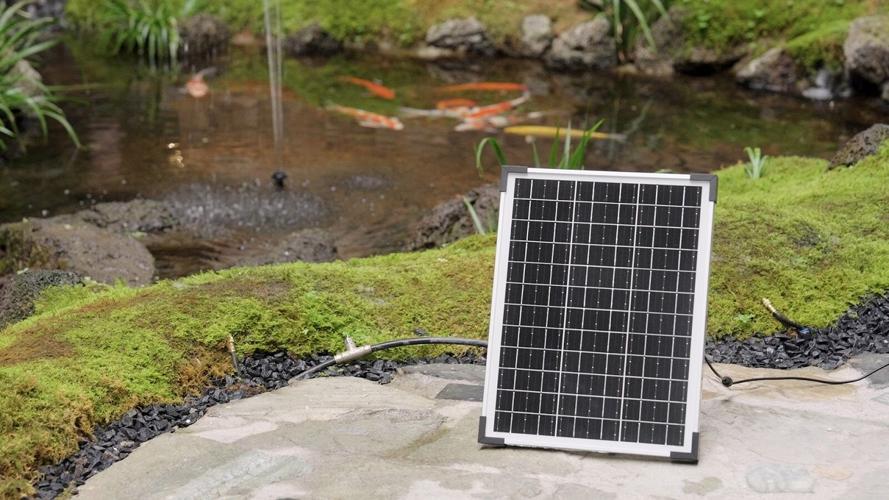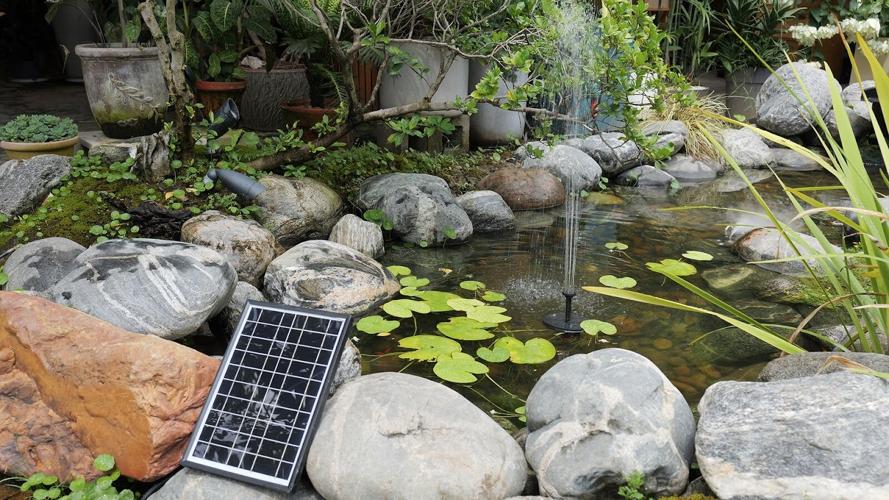Are you wondering if you can replace your old electric fountain pump with a solar one? Have solar fountain pumps developed to the point where they can achieve the same effect as electric pumps? I had the same question before. The answer is "yes," but there are a few things to consider. So I thought it would be interesting to do a small test. I have a pool of water here, along with my electric pump and solar pump, which I'll place side by side to show you the differences.
I started this pondless water feature project about four years ago, and in those years, solar pumps have advanced by leaps and bounds. So I wanted to test: Can a solar powered water pump achieve the same effect as an electric pump? Is it suitable for a small backyard water feature? What should you pay attention to when purchasing one? Which parameters are important? And how do you use it?

Basic Features and Connection Methods of Two Fountain Pumps
First, let's look at this electric pump. It needs to be plugged into a wall outlet, and I've been using it for several years. Currently, it doesn't have a fountain nozzle installed on top. Then, this is the small solar fountain pump I recently bought. I didn't use a rigid plastic pipe, but rather a flexible hose to connect to the areas needing a water supply, though the function is similar. It also has a cord, which I pulled over, a bit like "fishing"—this is the cord. So the first point to clarify is: don't assume it's wireless just because it's solar-powered. I initially thought so, but I was wrong. It must be wired because it needs to connect to the solar panel. This is the included solar panel; you simply plug the pump into it when in use. It also comes with a fantastic backup battery—my friend, this is crucial. If you're choosing a solar pump, definitely choose one with a backup battery. The advantage of my model is that it not only has a backup battery but can also connect directly to the solar panel.
The Role of the Backup Battery and the Limitations of a Battery-Free Solar Pump

The connection method is: the solar panel is first connected to the backup battery, and then from the battery to the pump. This way, when the solar panel absorbs sunlight, it can simultaneously charge the battery. It also comes with a power plug, which you could initially plug into an outlet to charge the battery. However, since the first full charge, I haven't used that plug—it can be fully charged by the solar panel. So I've always connected the solar panel and battery together, like a chain. The advantage becomes apparent after sunset: the backup battery automatically starts. But I want to show you what happens without the backup battery. Let's demonstrate with the pump itself—what happens if you don't buy a backup battery.
It comes with a small plug, which isn't standard on all solar pumps; it's unique to this model. Just connect the plug and tighten it. Then, supposedly, the solar panel needs to be placed at an angle of about 30 or 45 degrees for the pump to work. But as you can see, it's not responding at all because there's not enough sunlight. Although it's cloudy today, the weather is actually quite good. So this is the reality of solar pumps, especially those without a backup battery—the pump won't work without the sun. If this isn't an issue for you, then of course you can choose this type. However, I wanted the solar pump to achieve the same effect as the electric pump. My electric pump has a timer, which is very easy to set up; for example, it automatically starts when I get home from get off work and automatically turns off at 9 pm. Therefore, a solar pump without a backup battery doesn't meet my needs, and I just wanted to demonstrate this. It does work on sunny days, but as soon as the sun goes down, even if you walk past the solar panel or your shadow blocks it, the pump stops working. This is quite interesting.
Actual operating effect of the solar pump with a battery
But this backup battery is really useful. It has two interfaces. The method is to first unplug the pump from the solar panel and then connect the backup battery to the solar panel. Make sure to plug it in firmly and tighten the screw. Then, connect the wire from the other end of the backup battery to the fountain pump. I've been using this connection method for over a month, and honestly, the effect is much better than I expected; it's really surprising. You see, it's already working in this bucket.
That's it; now it's actually running on the backup battery that's been charged by the solar panel. I put it in the water for a while. Okay, now I'm going to compare it with the electric pump.
Actual Water Output Comparison of the Two Pumps

Now let's see the difference in actual performance. I also put the electric pump in the water; now both pumps are in this small pool. I'm really praying I don't get splashed.
Okay, no problem. I installed a diverter on this electric pump because its power is too much for me. There's a small switch here; turning it adjusts the amount of water sprayed from the top, and excess water drains out from the side. Now I've completely turned off the diverter, so you can clearly see the power difference between the two pumps.
You can see that the electric pump's water output is significantly stronger than the solar pump. But in my experience, I haven't noticed a big difference, probably because I usually only use the electric pump at half its power. Yes, that's about how high I usually go. So, since I don't use the electric pump at full power, the solar pump is quite suitable.
Purchase Recommendations
Based on this test, my recommendation is: if your current electric pump runs at full power all the time, when choosing a solar pump, it's best to choose one with a higher power output, or at least one with the same "gallons per hour" as the electric pump, because the only major difference is the flow rate. Their maximum head is similar. So, if your electric pump always runs at full speed, choose a solar pump with a comparable flow rate.
Okay, to summarize, if you're choosing a solar pump, definitely choose one with a backup battery. Everyone should check out the Popsoap model; its backup battery is incredibly useful. I've never seen anything like it. For solar pumps, this is absolutely a "game-changer" design.
Related Articles:
Luxury Air: How HVAC Companies Are Redefining Comfort in the Age of Smart Homes and Climate Extremes




(0) comments
We welcome your comments
Log In
Post a comment as Guest
Keep it Clean. Please avoid obscene, vulgar, lewd, racist or sexually-oriented language.
PLEASE TURN OFF YOUR CAPS LOCK.
Don't Threaten. Threats of harming another person will not be tolerated.
Be Truthful. Don't knowingly lie about anyone or anything.
Be Nice. No racism, sexism or any sort of -ism that is degrading to another person.
Be Proactive. Use the 'Report' link on each comment to let us know of abusive posts.
Share with Us. We'd love to hear eyewitness accounts, the history behind an article.